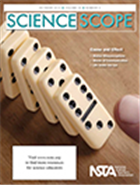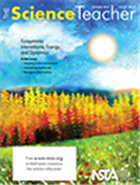 Science and Children
Science and Children
Establishing an understanding of patterns is important in childhood development. This issue of S&C is filled with ideas and resources you can use to help students make connections and understand the relationships that cause patterns.
Featured articles (please note, only those marked “free” are available to nonmembers without a fee):
- A Pattern in the Sky
- A SeQRet Treasure Hunt
- Free – Art and the Cosmic Connection
- Free – Editor’s Note: Crosscutting Concepts: Patterns
- Find Your School’s Analemma
- Modeling Water Filtration
- Full Table of Contents
Science Scope
 Knowing how to argue from evidence when attributing an observed phenomenon to a specific cause is an essential skill for any scientist. We hope the articles found in this issue will help teach your students to accurately identify and explain cause-and-effect relationships, both inside and outside the classroom.
Knowing how to argue from evidence when attributing an observed phenomenon to a specific cause is an essential skill for any scientist. We hope the articles found in this issue will help teach your students to accurately identify and explain cause-and-effect relationships, both inside and outside the classroom.
Featured articles (please note, only those marked “free” are available to nonmembers without a fee):
- Conservation of Matter in the Life Sciences
- Free – Editor’s Roundtable: Cause and Effect
- Generating, Evaluating, and Modifying Scientific Models Using Projected Computer Simulations
- Free – Lakes Alive!
- Model Synergy: Combining Classic Modeling Practices and Digital Simulations to Augment Deeper Conceptual Understanding
- Students Modeling Molecule Movement Through Science Theater
- Teaching Electromagnetic Waves Used in Communication Technologies
- Full Table of Contents
 The Science Teacher
The Science Teacher
There can be no argument about the importance of ecosystem ecology to the modern science curriculum. Interdisciplinary by nature, the field involves chemistry, physics, biology, and Earth science and core ideas like energy, matter and its interactions, biodiversity, Earth’s systems and their related human impacts, and engineering solutions. The intricate interactions involved in even the simplest ecosystems can help students understand the messiness of science and the complex functioning of natural systems, fluxes, and reservoirs. Furthermore, the future of our planet depends on understanding and protecting vulnerable ecosystems.
Featured articles (please note, only those marked “free” are available to nonmembers without a fee):
- Adapting to the Environment
- Free – Calculating Biodiversity in the Real World
- Free – Editor’s Corner: Ecosystems on the Brink
- Next Generation Botany
- Putting New Life in an Old Lesson
- Scientists at Work
- Full Table of Contents
Get these journals in your mailbox as well as your inbox—become an NSTA member!
The mission of NSTA is to promote excellence and innovation in science teaching and learning for all.
Follow NSTA
| |
|
|
|


